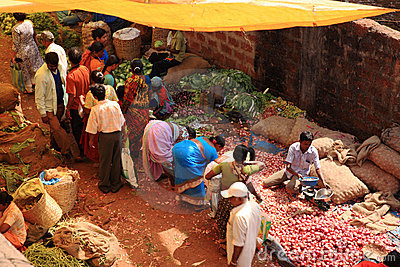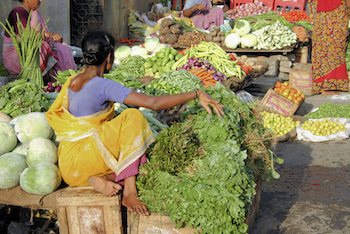Food Supply Chains & Markets

For people at the Base of the Pyramid (BoP), the nearly 4 billion people that earn less than USD4 per day and live primarily in Asia, Africa and South America, up to 80 percent of their disposable income is spent on food (WRI, 2007).
There are three key factors that have a major impact on their food and nutrition security: food prices, production for own consumption and household incomes. Typically, poor households live on one-dimensional staple-based diets and lack access to nutritious foods such as fruits, vegetables, meat, or dairy products. It is assumed that the higher the income a household or individual has to spend, the more divers’ food – and better quality food – the household or individual will be able to purchase.
Around 70 percent of the BoP population depends on food production for their income, either as smallholders or entrepreneurs. Although they are by far the largest investors in agriculture many smallholders are net food purchasers rather than net food sellers. Due to their limited holdings of land and/or suboptimal production methods, they do not produce enough food to satisfy their own needs. Small holder farmers should be central to all policies and programs and public investment remains essential. Stable agricultural markets are a requisite for reliable income for small holder farmers.
In a food supply chain (WEF 2009), a network of enterprises moves agricultural inputs and food products from production through various activities to consumption. The farmer obtains inputs such as seeds, fertilizer, pesticides, and water from input suppliers. The products are directly sold, consumed or further increased in value at the farm through community processing. Products that can be sold to consumers – by the farmer himself or via an intermediary – or to larger food processors and traders.
Although supermarkets are spreading rapidly in low-income countries, local food markets are still most relevant for the majority of both smallholder producers and consumers. Interventions that focus on “local-production-for-local-markets” can lead to an improvement of the local economic ecosystem (e.g., income generation through smallholder production) as well as a strengthening of the local food system. Improved sanitation, food handling, and storage technologies in local food supply chains and markets can boost efficiency and improve the safety and nutritional quality of foods.
Food markets

Marketing systems are undergoing rapid transformation. Traditional marketing channels with direct sales from producers to consumers are being replaced by longer value chains, including farmers, processors, retailers and others, particularly for the export sector and for supplies to local processors and supermarkets. As incomes increase, food consumption patterns are changing, with a greater emphasis on meat, dairy products and fruits and vegetables. Consumers are becoming more demanding in terms of quality and safety and demographic and income trends are leading to increased demand for convenience foods, together with assurances of product safety. New and more complicated “value chains” are emerging to meet these demands.
Improvement of marketing linkages for both farm produce and inputs necessitates a strong private sector backed up by appropriate policy and legislative frameworks and effective government support services. Such services can include provision of market infrastructure, supply of market information, and agricultural extension services able to advise farmers on marketing. Training in marketing at all levels is also needed; from farmer groups to post-graduate students at universities.
Market information services
Recent years have seen an increased interest in market information services (MIS). Efficient market information provision can be shown to have positive benefits for farmers, traders and policy-makers. Up-to-date market information enables farmers to negotiate with traders. Well-analyzed historical information and knowledge about trends in consumer demands helps farmers make decisions about new crops to grow and helps traders make decisions about the viability of inter seasonal storage. Market information can also be used by planners to help monitor food availability and to identify shortages.
Market information enables farmers to make informed decisions about what to grow, when to harvest, to which markets the produce should be sent, and whether or not to store products. Recent ICT developments in developing countries, such as the expansion in the use of cell phones, have opened up the possibility for more speedy transmission of information. However, it remains essential that the information transmitted is accurate. The problem of transmitting reliable information on a sustainable basis has been faced by many MIS in the past. FAO is active in promoting efficient and sustainable market information services. The Connect4Change coalition , a consortium of five Dutch development organizations supporting development by effective use of ICT, also supports the development and functioning of MIS. In for example Burkina Faso the TV program Koodo provides market price information to over 1 million viewers with support from Connect4Change.
Acknowledgements
- BoP Innovation Center. Access to Food and Improved Nutrition at the Base of the Pyramid.
- FAO, 2013. The state of food and agriculture.
- Concord, 2014. Position paper on Food Security.
- Connect4Change, economic development sector.


